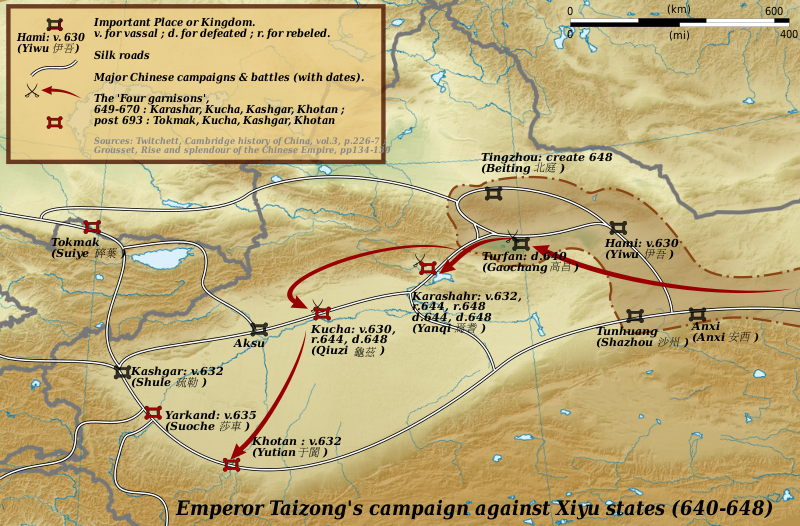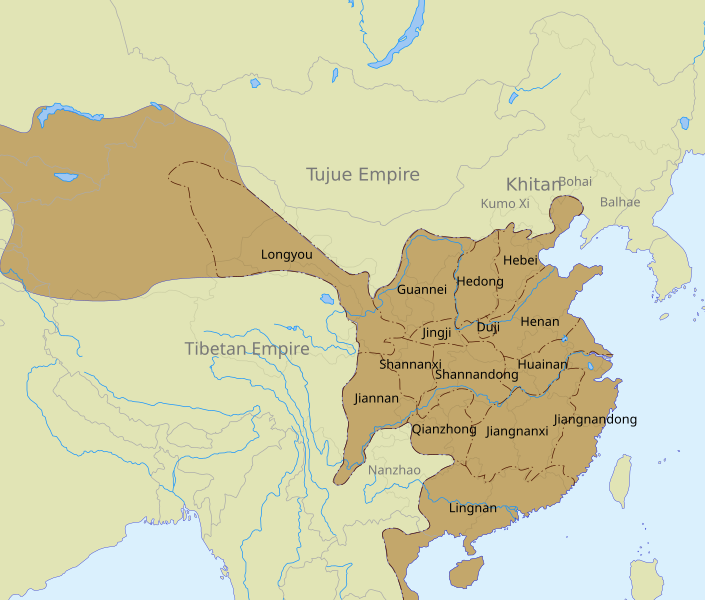
he conquest of the Western Turks, known as the Western Tujue in Chinese sources, was a military campaign in 657 led by the Tang Dynasty general Su Dingfang against the Western Turkic Khaganate ruled by Ashina Helu. The Chinese war against the Western Turks began in 640 with the annexation of the Tarim Basin oasis state Gaochang, an ally of the Western Turks. Several of the oasis states had once been vassals of the Tang Dynasty, but switched their allegiance to the Western Turks when they grew suspicious of the military ambitions of the Tang. Tang expansion into Central Asia continued with theconquest of Karasahr in 644 and Kucha in 648. Su Dingfang commanded the main army dispatched against the Western Turks, while the Turkic generals Ashina Mishe and Ashina Buzhen led the side divisions. The Tang troops were reinforced by cavalry supplied by the Uyghurs, a tribe that had been allied with the Tang since their support for the Uyghur revolt against the Xueyantuo. Su Dingfang's army defeated Helu at the battle of Irtysh River.
The victory strengthened Tang control of the Western Regions, now modern Xinjiang, and brought the regions formerly ruled by the Khaganate into the Tang empire. Puppet qaghans, the Turkic title for ruler, and military garrisons were installed to administer the newly acquired territories. The Tang Dynasty achieved its maximum extent as China's western borders reached the eastern frontier of the Arabic Umayyad Caliphate. Later on, Turkic revolts ended Chinese hegemony beyond thePamir Mountains in modern Tajikistan and Afghanistan, but a Tang military presence remained in Dzungaria and the Tarim Basin. Central Asia absorbed cultural influences from the conflict. Turkic culture and language spread into Central Asia, as did artistic and political influences from the Tang Dynasty. Many of the Tang generals and soldiers stationed in the region were ethnically Turkic, and the prevalence of Indo-European languages in Central Asia declined with acceleration of Turkic migration. The Turks, Tibetans, and the Tang competed for control over Central Asia for the next few centuries.
he empire of the Tang Dynasty (June 18, 618 – June 1, 907), successor of the Sui Dynasty, was a cosmopolitan hegemon that ruled one of China's most expansive empires.[4] Raids by the nomadic Khitans and Turks challenged Tang rule, and Tang rulers responded by pursuing strategies of divide and conquer, proxy warfare, tributes, and marriages.[5]
Hostilities between the Tang and the Western Turks had existed since the founding of the dynasty.Emperor Gaozu, the first emperor of the Tang Dynasty, aided the assassination of a Western Turk qaghan in November 2, 619.[6] Facing the threat of both the Western and Eastern Turkic Khaganates, Gaozu's successor Emperor Taizong formed an alliance with the Western Turks against the Eastern Turks, adopting a policy of allying "with those who are far away to fight those who are close."[7]
The westward expansion of the Tang Dynasty began with their wars against the Eastern Turks, Eastern Tujue in Chinese.[5] Taking advantage of the political discord in the Eastern Turkic Khaganate, Taizong annexed the territory of the Eastern Turks in 629, beginning a period of rule that would last for the next fifty years.[8] The nomads were driven out of the Ordos region and southern Mongolia and Taizong was declared a Great Khan by the defeated tribes, who surrendered and submitted to Tang rul

The conquest strengthened Tang rule over modern Xinjiang, administered by the Anxi Protectorate, and led to Tang suzerainty over the regions previously under the control of the Western Turks.[21] The fall of the Khaganate brought the Altai Mountain region under Tang control and the residing Three Qarluq tribes were governed in newly established prefectures led by tribal chiefs, now commander-in-chiefs under the Tang.[29] Another prefecture, the Jinman Bridle Prefecture, was created for the Chuyue tribes living in the southern Dzungar basin.[19] The Amu Darya valley, the Tarim Basin, and the area beyond the Pamir Mountains, all former suzerains of the Western Turks, were placed under Tang control.[25]
Su continued his career as military general, and later commanded Tang forces in a war against Baekje in 660.[16] The Tang Dynasty achieved its maximum extent following its conquest of the Khaganate.[30] The inhabitants of the new territory did not become sinicized like many of the other kingdoms and tribes conquered by the Tang.[31] Tang military activity in Central Asia brought in a wave of Turkic migrants serving in the Tang military as soldiers and generals, leading to the spread of Turkic language and culture.[32] At the same time, the prevalence of Indo-European languages in the Western Regions was on the decline.[9] Central Asia also absorbed cultural influences from Tang China. Central Asian art incorporated Tang stylistic features, like the sancai three color glaze used in pottery.[33] Chinese coins remained in circulation in Xinjiang after the decline of the Tang.[34] Cultural remnants of Tang architectural influence are still visible in the Buddhist architecture of Dunhuang, on the border between the Western Regions and the Hexi Corridor.[8]
The sheer size of the newly conquered lands made it difficult to govern through the Tang military garrisons.[25] The Tang emperor Gaozong appointed two puppet qaghans to rule over the Western Turks, who were later overthrown in a rebellion that began in 662. The revolt reduced Tang's western extent to Beshbalik, Dzungaria in northern Xinjiang and ended direct Tang control of Central Asia beyond the Pamir Mountains in modern Tajikistan and Afghanistan. The expansion of the Tibetan Empire from the south threatened China's hold on southern Xinjiang.[30] Tibet invaded the Tarim Basin in 670, but Tang forces regained the area in 693 and Kashgar in 728, restoring the Anxi Protectorate and Four Garrisons. The conflict between Tibet and the Tang continued for the remainder of the Tang Dynasty.[35]
At its maximum extent, Tang expansion brought China into direct contact with the rising Umayyad Caliphate. China's western borders reached the eastern frontier of the Caliphate.[30] Following the Arab defeat of Sassanid Persia in 651, the Caliphate began its expansion into Central Asia, competing with the Tang's sphere of influence in the region. Chinese and Islamic troops finally clashed at the Battle of Talas in 751.[36] The Chinese lost against the Arabs, now under Abbasid rule, and the Arab army captured Chinese papermaking craftsmen. An Arabic record of the conflict claims that the battle led to the introduction of papermaking to the Islamic world
No comments:
Post a Comment